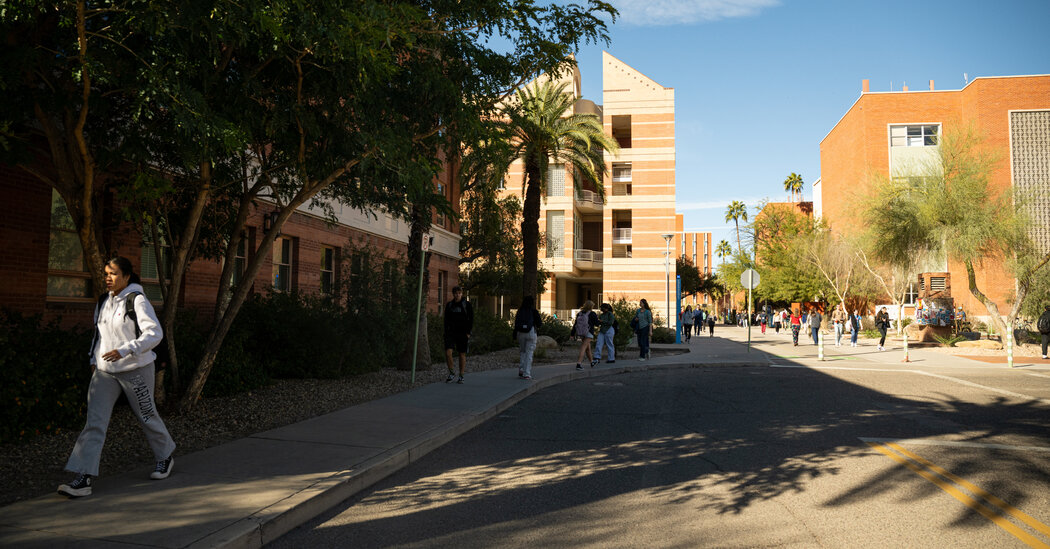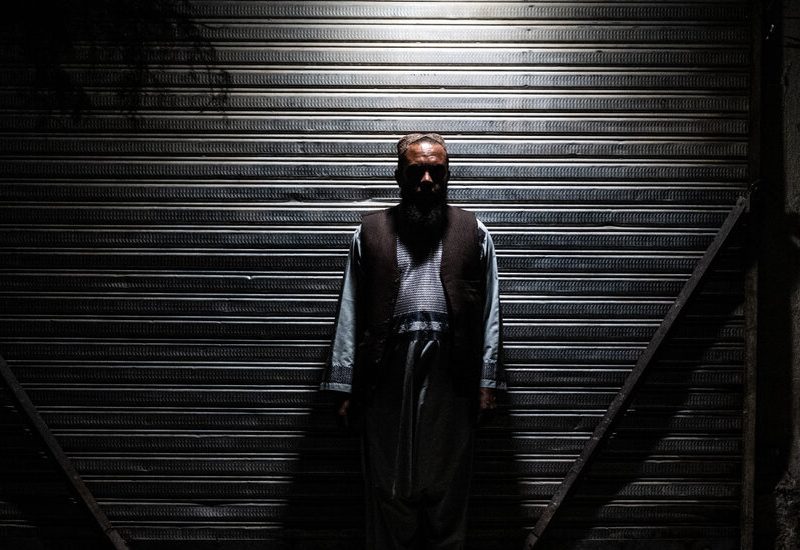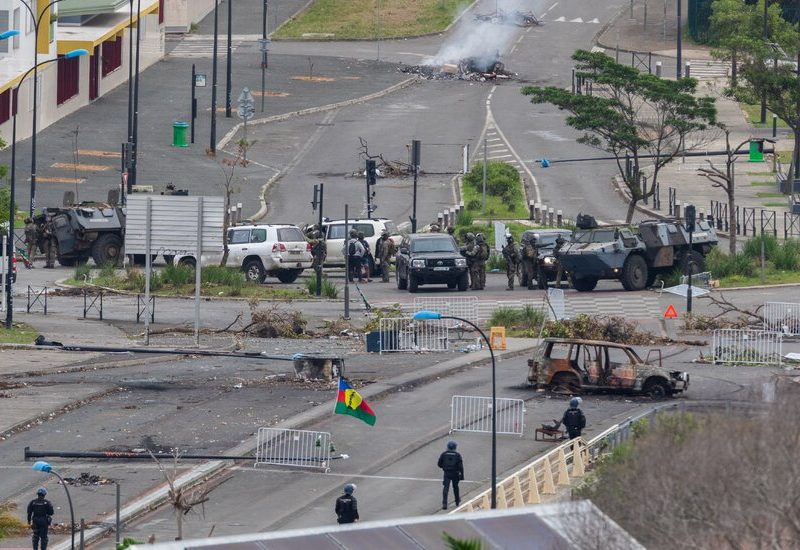Like thousands of people in southern Arizona, Josh Ramos’s fate is intertwined with the University of Arizona. His mother’s job as a university accountant supports the family, and Mr. Ramos’s education, by qualifying him for a discount that cuts his tuition by 75 percent.
“This job has brought us a lot of stability,” said Mr. Ramos, 18, a college freshman.
But the University of Arizona stunned the state late last year by revealing a $177 million shortfall in its more than $2 billion annual budget. Now, as the 40,000-student campus braces for layoffs, Mr. Ramos is worried. About his mother’s job. About having to drop out. About his family’s future.
And the whole state is worried that southern Arizona will suffer if the region’s largest, most dependable employer loses credibility and trust.
The turmoil has shaken the heavily Democratic city of Tucson, where many residents and university employees blame mismanagement at the top.
They say university leaders bumbled into catastrophe by spending millions of dollars on top-end salaries, athletics, risky expansion efforts and tuition subsidies for out-of-state students. Now they worry that middle-class workers and Arizona students will be hit hardest by efforts to cut budgets.
“It’s going to strike at the heart of Tucson,” said Leila Hudson, an associate professor and chair of the faculty.
Other flagship public schools including Penn State and West Virginia University have grappled with budget cuts recently because of inflation and sagging enrollment. But the problems at Arizona galled many people there because the school appeared to be booming. Student numbers and revenues are rising, and the university is earning more money from research grants and state funding.
The university’s administrators say that inflation, the pandemic and widespread overspending have contributed to its financial problems, and that they are trying to fix the budget without hurting the university’s academics or research. They say that despite the deficit, the university is not in danger of running out of cash.
“The university has lost some credibility in the community, and a little trust we need to regain,” John Arnold, the interim chief financial officer, said in an interview. Mr. Arnold is also the executive director of the Arizona Board of Regents, which oversees Arizona’s public universities.
The university’s response has failed to satisfy its critics, or Gov. Katie Hobbs, a Democrat. In a letter to university leaders last month, she said there was “no coherent vision” for a way forward, and criticized the school for a lack of accountability and transparency and threatened to change its leadership.
To some, the financial mess highlights a widening class divide in higher education, where top administrators and coaches can make $1 million a year while lower-tier instructors and part-time faculty say they scrape by on less than $50,000.
Faculty members say they already endured furloughs during the pandemic, and that teaching slots and staff jobs have sat empty in recent years. While they struggled to keep up, they said, the university acquired a troubled for-profit online college and spent more than $60 million to prop up the athletic department.
The university’s president, Robert C. Robbins, struck an optimistic tone in a Feb. 9 update that described the school’s financial plans, saying, “I am confident that, together, we will emerge from this challenge stronger.”
But that has not assuaged the anxiety and anger on campus, which grew after The Arizona Daily Star reported that Lisa Rulney, the university’s chief financial officer who resigned amid the mess, had stayed on as an adviser and was still being paid a $500,000 salary. Ms. Rulney did not respond to requests for comment.
“We’re all on the same stormy seas, but they’re in yachts, and we’re in rafts,” said Gary Rhoades, an education professor who has spent months delving into the university’s spending to understand the roots of the problems.
The university has now frozen hiring and pay raises, and faculty members who have been tracking the budget discussions said they were bracing for as many as 1,000 job cuts. Earlier this month, the administration asked individual schools and departments to sketch out budget cuts from 5 to 15 percent.
A union representing campus workers says about a handful of people on year-to-year contracts have already been laid off.
Students and campus workers have responded by holding protests outside the administration building, urging leaders to “chop from the top.”
They urged the university to start with its dozens of vice presidents instead of targeting rank-and-file workers. Mr. Arnold, the interim head of finance, said the university would be scrutinizing “every one” of its vice presidents. Expanding bureaucracies have also plagued other universities and colleges, and led to higher administrative costs and tuition.
The chasm between the university’s five- and six-figure workers is particularly acute in a city like Tucson, population 540,000, where an influx of buyers during the pandemic helped push median house prices to $385,000 from about $250,000.
Even the university’s food pantry is straining: It announced this winter that rising prices and more users had forced it to stop offering hygiene products and cut back on some of its food options.
“I’m so excited to work here, and I feel like the school is not excited to have me,” said Spencer Gantt, who works in information technology and is a member of United Campus Workers Arizona, the local union that has organized most of the demonstrations against layoffs.
Jobs like Mr. Gantt’s may be some of the most vulnerable. A financial plan released this month showed that the university would start cutting costs in administrative areas such as human resources, marketing, communications and, to Mr. Gantt’s dismay, information technology.
“I’m very scared,” he said. He worried about not having a job a month from now, and said he didn’t even know whether he was at risk of being laid off. He is putting off getting an oil change on his Toyota Corolla until he has some certainty.
Some students and staff members say they have started to notice the effects of the money problems. Samantha Gonsalves Wetherell, 21, said she was saddened that the university delayed releasing a climate-action plan that she had spent much of her undergraduate years helping to create.
“We’re all looking for answers, but nobody knows,” said Maria Sohn Hasman, a program coordinator working at the university. “I wake up every single day wondering if today’s the day I’m going to be laid off.”
The university has yet to detail all of the cuts, but says it plans to save $27 million by permanently eliminating vacant jobs. It also said it would hire outside consultants to scrutinize the finances of the athletic department and a polarizing new online venture, the University of Arizona Global Campus.
The university started the program by paying $1 to acquire a for-profit, online-only school called Ashford University in 2020. The deal added tens of thousands of new online students to the university’s rolls.
But critics say it also saddles the university with more than $200 million in new costs, and yokes the university to a school that state and federal officials say cheated students by misleading them about costs and the value of their degrees, leaving them with little to show but debt.
On Tuesday the Arizona Board of Regents released a report detailing how and why it had acquired Ashford, in response to Arizona’s governor demanding more information about the deal. The board said it had not “brushed aside” concerns about Ashford’s business practices, and said Ashford had assured the university that those “practices had been corrected.”
Lawyers who have represented Ashford’s parent company did not respond to requests for comment.
The university said its global campus had been “cash positive” for the university so far, largely because the university received an infusion of money with the acquisition. The global campus is expected to run a $2.5 million deficit in the current fiscal year but make money next year, according to the university’s budget projections.
Pam Scott, a university spokeswoman, said the new campus lets the university “provide thousands of more students access to a high quality, world-class education — students who otherwise might not have the opportunity.” Since taking over, the university says it has shifted focus away from recruiting students and toward keeping them in school and on a path to success.
With nearly 17,000 workers, the university is the largest employer in the Tucson area, and it says it pumps about $4 billion into the economy each year.
Even amid the turmoil, the sunny red brick campus pulses with energy and academic feats.
Enormous mirrors built in a university lab beneath the football bleachers are used to peer into the deepest corners of space. Students inside a campus building made to resemble a desert canyon are busy learning about sustainable desert agriculture. Scientists who have pioneered the science of studying tree rings are using them to decipher climate change and ancient disasters.
One afternoon last week, Hadi Alim, 22, breezed past all of it as he contemplated whether his family would have a future on campus. His father, who works maintaining the university’s computer networks, has started driving for Uber in case he loses his job.
Mr. Alim, a college junior studying sustainably built environments, pays his own tuition, which he said he could afford only because of the discount he gets as the son of an employee. He said he had started looking at finishing college abroad, somewhere cheaper, as a fallback.
“I just try and take it one day at a time,” he said, “and graduate as soon as possible.”



